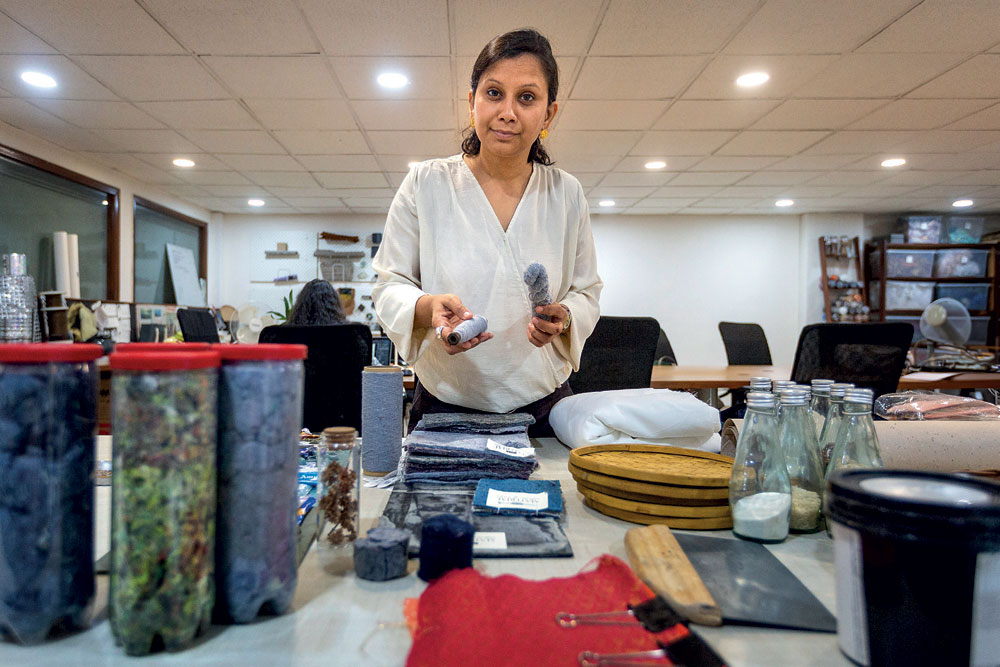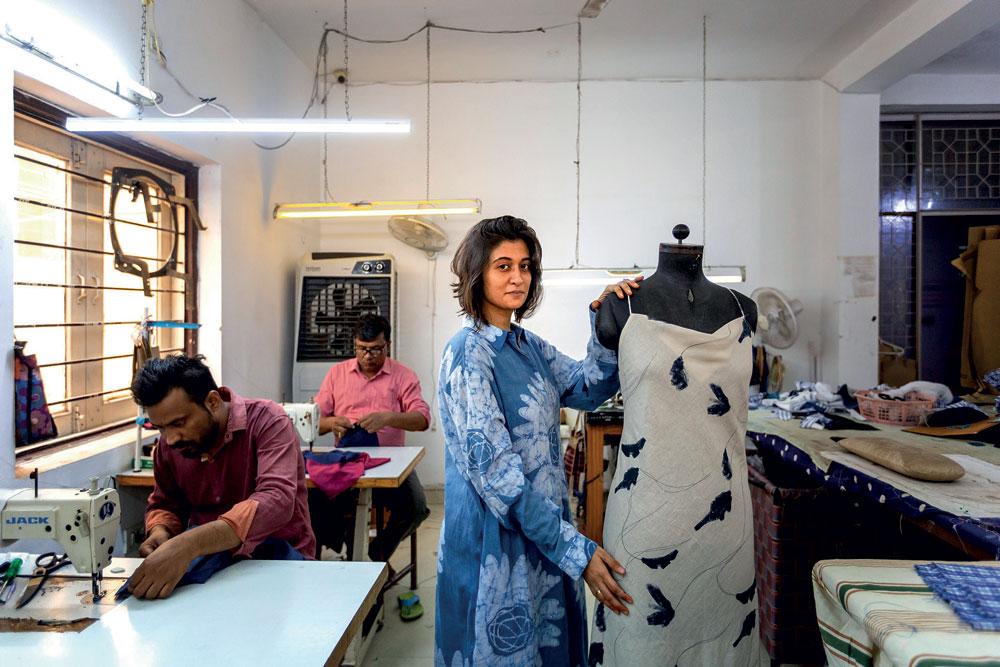Rags to Riches
A new breed of entrepreneurs is making cash out of trash
 Moinak Mitra
Moinak Mitra
 Moinak Mitra
Moinak Mitra
 |
10 Nov, 2023
|
10 Nov, 2023
/wp-content/uploads/2023/11/Ragstoriches1.jpg)
Naman Gupta, cofounder, Core Effort (Photo: Ashish Sharma)
The ubiquity of the cigarette butt gets Naman Gupta’s goat every now and then. So, he decided to turn it into a utility. Coming from a non-smoking background, he considered the omnipresent tobacco stubs as “cotton”. And mass littering has been a perennial pain point with him. Five years back, Naman got together with his brother Vipul and developed a solution through which the duo could recycle cigarette butts. “Once we had the solution, we formed a company and started awareness campaigns for proper disposal of the cigarette butts,” says the 29-year-old BCom graduate from Delhi.
Today, their venture, the Noida-based Core Effort, makes every cigarette butt count, literally. Think compost, handmade paper, mosquito repellants, soft toys, cushions, keychains, wearable textile. From tobacco, 1-2 per cent of a cigarette butt, the company derives compost. “Our compost has a high NPK value and we sell it across gardens and nurseries in and around Noida,” says Naman. And from the paper (45-46 per cent of the butt), the utility is manifold—mosquito repellants, handmade paper sheets, carry-bags, envelopes, wrapping paper, stationery items. “Once the raw cigarette paper is available to us, we deploy 100-odd women in a village in Noida to manufacture the finished product,” says Naman. The third and final component (50 per cent of the raw material) is the cigarette filter, or fibre, which goes into a shredding machine and then treated with a homegrown chemical composition. It is then washed, dried and softened to make soft toys, cushions and keychains, all of which are handstitched. “Last year, we developed a textile from the filter and since it is very heavy, it acts as good insulation wear.”
Along with a new breed of social entrepreneurs, Naman has been able to create wealth out of waste, and the results are now showing. At present, Core Effort covers 200 districts pan-India from where suppliers provide the raw material (cigarette butts). The company has collected 3 billion (300 crore) butts since inception, and has recycled close to 2 billion of them. In the process, more than 2,500 ragpickers have been mobilised.
According to a report by The Energy and Resources Institute (TERI), India generates over 62 million tons (MT) of waste each year. Only 43 MT of waste gets collected with only 12 MT being treated before disposal. Every social entrepreneur in the country’s waste-scape is fighting for a piece of that pie.
In Pune, 34-year-old Anish Malpani has given eyewear a glad eye by converting wafer/chips packets to sunglasses. The former finance pro from New York found new meaning launching his company Ashaya in 2020 and started operations the following year. “We’re a pandemic baby,” he chortles, resolving to lead a crusade against the devastating impact of plastic waste on the environment.
“We have assembled 4-5 machines that can recycle cigarette butts. Our USP is a chemical composition that can detoxify the effluents which are present in the cigarette filters. The paper and the tobacco are also recycled and converted into different products,” says Naman Gupta, cofounder, Core Effort
Ashaya works directly with the Swach cooperative in Pune and collects plastic waste (read chips packets) from them. “We get 100kg of plastic [waste] a month and make about 1,000-2,000 sunglasses from them. One sunglass takes about five packets of chips,” says Malpani after a back-of-the-envelope calculation.
The chips packets-to-sunglasses technology has been patented in India. “It is a chemo-mechanical process that separates the multi-layered [plastic] packaging and extracts material from it, and then converts those raw materials into high-quality materials,” explains Malpani.
The sunglasses vend under the brand name ‘Nothing’ and launched in February this year. At ₹1,599 a pop, “we sold out within six days despite all the sunglasses having the same dimensions and colour.” Each of the sunglasses are UV polarised and come with a QR code, and on scanning the code, tell the story of how they have been recycled.
Malpani’s next move is to test the technology to scale. “Right now, we do 5kg/day. The next step will be to do 100kg/day. We’ll build a pilot plant scalable to much larger amounts.” So far, two designs of sunglasses are on offer on the company’s website and there are plans to foray into jewellery, lamps, coasters. “Think of us as sustainable fashion,” pinpoints Malpani.
Around 22km away from Ashaya, Jayant and Suchismita Pai have launched a crusade to better the lives of waste-pickers by empowering them to get more bang for their buck. Like Malpani, the couple is associated with Swach, a cooperative founded and run by 38,000-odd waste-pickers that runs on a user-fee model.

The duo launched ‘The Protoprint Project’ in 2012 by developing a low-cost shredder/extruder to add value by converting plastic waste to flakes. Subsequently, the project experimented with 3D printer filament from plastic waste and set up a pilot filament production facility. In 2015, it began operations with a small group of waste-pickers focused predominantly on flake production. Down the line, the project experimented with hand-powered injection moulding techniques to design artisanal products and consumer items from waste plastic, and even improved its 3D printer filament quality. Three years back, it embarked on the construction of over 50 distributed plastic processing facilities in collaboration with the Pune municipality.
“We get 100kg of plastic [waste] a month and make about 1,000-2,000 sunglasses from them. One sunglass takes about five packets of chips,” says Anish Malpani, founder, Ashaya
Simply put, a waste-picker typically sells plastic, say a shampoo bottle, to a scrap dealer for ₹20/kg. When that shampoo bottle is shredded and gets converted to flake, it sells for ₹80/kg—a fourfold increase; and when that flake is converted to filament, it fetches ₹800/ kg, a hundredfold hike. Disintermediation is key as the waste-picker directly deals with the buyer, negating exploitative scrap dealers. That was one of the mandates of The Protoprint Project from the word go.
As value gets generated in the process, the profit gets divided among waste-pickers. What more can the project do? “The whole concept of ‘Protoprint’ deals with printing prototypes. Suppose there’s an engineering student who wants to do a prototype—injection moulding is not possible since you have to make a dye and print many of those [prototypes] to be worth your while. This is where 3D printing comes in to do an innovation or test out a product,” explains Suchismita, adding an array of opportunities the project can look at. “HP can buy filaments from us since they have 3D printers; even hobbyists have 3D printers; or I can sell filaments on Amazon; or I may choose to sell to institutions like engineering colleges for all their 3D printer needs,” she elaborates.
Back in Noida, where Core Effort dabbles in cigarette butt therapy, Shubhi Sachan’s ‘Material Library of India’ (MLI) has taken root. “People often think I love waste, the truth is I hate it so much that I want it to end at its generation point,” is a quote from her that hangs prominently on her website. Founded in 2017, MLI’s endeavour is “to find a solution to waste by helping people do last-mile integration of it,” claims the 36-year-old Sachan.
A textile student, Sachan started working for home furnishings major Welspun, and thereafter worked for several top fashion labels, such as Ralph Laren, Givenchy, Balmain and Alexander McQueen. “I saw they were generating a lot of waste while making designer wear and it was difficult turning a blind eye to it, and so I decided to have a more systematic approach,” says Sachan, who now deals with all kinds of materials, not merely textiles.

From 2012 onwards, she started doing projects and consulting workaround materials and has been a profit-making venture from day one. “We firmly believe that if we do not understand the material, we cannot solve the larger issue,” she says.
MLI has already helped pharma major Dr Reddy’s in a project by turning pharma waste into lifestyle products. Also, it developed a matrix for Godrej to help the company understand its own waste flow.
As Sachan sets up her textile recycling facility in Noida, her current range of upcycled pillows and yardages made from industrial waste are already on the shopfloor.
“If we do not understand the material, we cannot solve the larger problem. In 2013, I started working with agricultural waste but we have been primarily working with a lot of industrial waste,” says Shubhi Sachan, founder, Material Library of India
In neighbouring Delhi, Kriti Tula is busy making sustainable fashion out of pre and post-consumer waste fabric and promoting low-impact raw material to cotton, leather, polyester and viscose through her collections that she vends under her company name Doodlage.
Armed with a Master’s in fashion from London, Tula, 34, was quick to realise the wastage in the fashion world, and wanted to do something about it. “Having studied fashion and worked in exports, I was well aware of the quantities of wastage in the fashion industry and understood the impact of this wastage on the environment,” says Tula, giving out the rationale behind Doodlage.
Today, the company receives fabric waste from factories which are checked for defects and fixed with hand by artisans before being converted into collections. If the waste lands up as scrap, it is patched back by artisans in order to create products. For the recycled material, Tula & Co work with handloom units that weave recycled yarns to create fabric for them. “These yarns are made in factories that shred garments back to fibre, blend them with new fibre for strength and convert them to yarn,” informs Tula, adding that the company has also worked with alternative materials like cactus, leather, cork, bamboo, plant-based wool, etc.

So far, Doodlage has worked across the corporate spectrum by creating merchandise, gifts, uniforms, and even providing workshops on campuses. It counts AB InBev, Meta, Shell India, payU, Mercedes, Hyundai and Penguin India as some of its clients. “Our aim is to add more products to the range and make our offering more affordable, add some physical stores, grow international partnerships, do more collaborations,” highlights Tula.
Not far, in the industrial hub of Okhla, sits Sanjay Chauhan’s MuddleArt that allows him to drive “meaningful change”. Through on-ground research and engagement with the textile waste sector, Chauhan and his team gained invaluable insights into pressing challenges and untapped potential.
“Having studied fashion and worked in exports, I was well aware of the quantities of wastage in the fashion industry and understood the impact of this wastage on the environment,” says Kriti Tula founder, Doodlage
The company offers customised textile waste management solutions with a focus on fostering circularity in the ecosystem. “By addressing brands’ and manufacturers’ sustainable waste management needs, we create employment opportunities for marginalised communities and safeguard the environment,” says Chauhan.
In a nutshell, MuddleArt procures waste from apparel manufacturers and sorts this mix into various categories, channelling forward to organisations that recycle or upcycle it. MuddleArt also makes the mix accessible to hundreds of rural artisans as raw material, who in turn convert it into affordable articles like kidswear, garments and undergarments, besides a variety of home utility products.
Currently in the R&D phase of its textile-to-fibre recycling unit, the company is on the verge of launching its own upcycling vertical. This will help the company achieve much of the recycling and upcycling inhouse. Since inception in 2019, the company has handled over 7,000 tons of fabric waste, with a monthly capacity of more than 800 tons.
While the government’s ‘Waste to Wealth Mission’ is an initiative that attempts to leverage global technological capabilities to create socio-economic benefits for the nation, it is private enterprise that is breathing new life to the garbage pile—be it from cigarette butts to soft toys, or chips packets to sunglasses, or plastic flake to filament, or for that matter, any material waste to quality products.

/wp-content/uploads/2025/01/Cover_Kumbh.jpg)












More Columns
The lament of a blue-suited social media platform Chindu Sreedharan
Pixxel launches India’s first private commercial satellite constellation V Shoba
What does the launch of a new political party with radical background mean for Punjab? Rahul Pandita